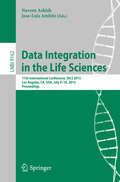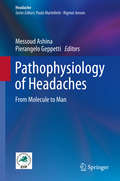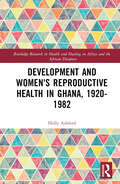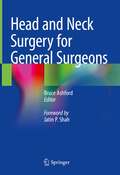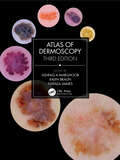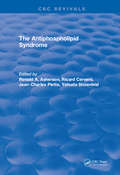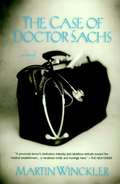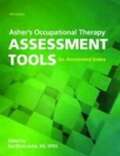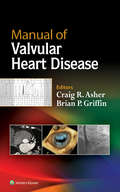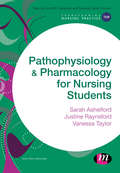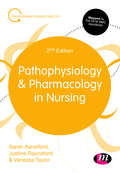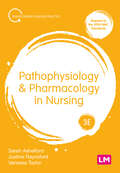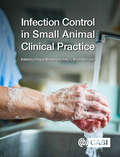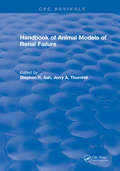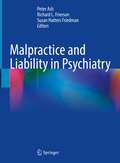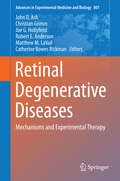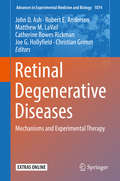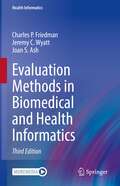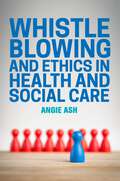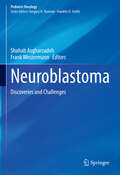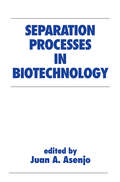- Table View
- List View
Data Integration in the Life Sciences: 11th International Conference, DILS 2015, Los Angeles, CA, USA, July 9-10, 2015, Proceedings (Lecture Notes in Computer Science #9162)
by Naveen Ashish Jose-Luis AmbiteThis book constitutes the proceedings of the 11th International Conference on Data Integration in the Life Sciences, DILS 2015, held in Los Angeles, CA, USA, in July 2015. The 24 papers presented in this volume were carefully reviewed and selected from 40 submissions. They are organized in topical sections named: data integration technologies; ontology and knowledge engineering for data integration; biomedical data standards and coding; medical research applications; and graduate student consortium.
Pathophysiology of Headaches
by Messoud Ashina Pierangelo GeppettiThis book provides a detailed overview of the current state of knowledge regarding the pathophysiology of both primary headaches - migraine, tension-type headache (TTH), and cluster headache - and the very important and frequent type of secondary headache, medication overuse headache (MOH). After an introductory chapter describing relevant neuroanatomy and vascular anatomy, the evidence gained from animal models regarding the pathophysiology of migraine and the other primary headaches is reviewed. Knowledge of the genetic component in the different types of headache is then examined with reference to recent evidence, for example regarding the implication of the trigeminovascular system and cortical spreading depression in migraine. Detailed information is provided on insights into primary headaches from imaging studies, including functional magnetic resonance imaging and positron emission tomography and on their neurophysiology and biochemistry. A further series of important chapters describe present knowledge of the pathophysiology of each specific type of headache and consider future directions. Written by acknowledged experts in their fields from Europe and the United States, clinicians and students will find Pathophysiology of Headaches to be an excellent source of up-to-date information on why patients experience headaches. In addition, it will be of value for pain researchers investigating the underlying mechanisms of headache.
Development and Women's Reproductive Health in Ghana, 1920-1982 (Routledge Research in Health and Healing in Africa and the African Diaspora)
by Holly AshfordThis book investigates the history of women's reproductive health in Ghana, arguing that between the 1920s and 1980s, it was largely driven by discourses of development and population control, rather than a concern for women’s health or rights. Between the 1920s and 1980s, the choices that Ghanaian women made regarding their reproductive health were defined by development policy and practice. Spanning the colonial and immediate postcolonial periods, this book demonstrates that whilst the substance of development discourse shifted over time, principles of development continued to be used to impact and legitimise reproductive health policy and practices well after independence. The book explores Ghana’s pluralist health system, the introduction of maternal and child welfare, the dominance of the Red Cross in Ghana’s maternal and child health landscape, nationalist pronatalism and global population activism. In order to understand how global iterations of development and health policy impacted on ordinary lives in Ghana, the author uses evidence from multiple ‘levels’, including private papers, national archives, and records of international and transnational organisations. Providing balanced archival perspectives, the book includes extensive oral history interviews carried out with both rural Ghanaian women and traditional birth attendants, as well as with midwives, doctors and family planning fieldworkers. This book will have an important impact on a number of historical fields including Ghanaian history, global health history, global histories of population and family planning and histories of development. It will be of interest to researchers and students in the history of public health, development, Africa, Ghana and gender.
Head and Neck Surgery for General Surgeons
by Bruce AshfordGeneral surgery is the common ancestor of all surgical specialties. Within general surgery, many subspecialty areas of practice have evolved. This book is the first manual recognizing the growing role General Surgeons play in Head & Neck Surgery. From benign to malignant conditions and form ablative to reconstructive challenges, the renowned comprehensive capability of the General Surgeon is well suited to demands of this discipline. Each chapter details relevant anatomical considerations to enable understanding of this complex regional specialty and the full range of head and neck pathologies with requisite assessment, investigation, surgical and relevant reconstructive techniques. Written by a multidisciplinary, international team of recognized experts, this textbook is a practical but comprehensive guide for both candidates preparing for final surgery examinations as well as general surgeons requiring an up-to-date source of definitive advice on topics of this regional specialty.
Atlas of Dermoscopy: Third Edition
by Ashfaq A Marghoob Ralph Braun Natalia JaimesThe much awaited third edition of the leading reference book in dermoscopy has undergone comprehensive revisions to all chapters, with updates and expanded content providing the reader with a more comprehensive and in-depth coverage of skin conditions, ranging from skin neoplasia to hair, nails, infections and inflammatory diseases. This compilation of contemporary dermoscopy knowledge will benefit the novice in building expertise and benefit experienced practitioners also by providing nuanced insights. Prepare to embark on a journey of learning as leading international experts in the field of dermoscopy explain via text and annotated exemplar images the amazing world of subsurface cutaneous colors and structures visible through a dermatoscope!
The Antiphospholipid Syndrome: Autoimmune Thrombosis
by Ronald A. AshersonWritten by the foremost researchers in the field, this book gathers together in a single source the many important clinical associations of antiphospholipid antibodies. Antibody-related clotting mechanisms and their relationship to conditions such as recurrent strokes, chorea, multi infarct dementias, a variety of spinal syndromes, Addison's Disease, recurrent miscarriages, and many more are discussed in depth. The importance of these antibodies in 'Primary,' 'Secondary,' and 'Catastrophic' Antiphospholipid Syndrome is highlighted. Each chapter is devoted to a specific internal system and the clinical effects this syndrome has on that system.This authoritative book is an essential addition to medical libraries as well as an invaluable reference for general physicians, internists, rheumatologists, neurologists, cardiologists, nephrologists, endocrinologists, gastroenterologists, pulmonologists, dermatologists, and obstetricians.
From Clone to Bone
by Robert J. Asher Johannes MüllerSince the 1980s, a renewed understanding of molecular development has afforded an unprecedented level of knowledge of the mechanisms by which phenotype in animals and plants has evolved. In this volume, top scientists in these fields provide perspectives on how molecular data in biology help to elucidate key questions in estimating paleontological divergence and in understanding the mechanisms behind phenotypic evolution. Paleobiological questions such as genome size, digit homologies, genetic control cascades behind phenotype, estimates of vertebrate divergence dates, and rates of morphological evolution are addressed, with a special emphasis on how molecular biology can inform paleontology, directly and indirectly, to better understand life's past. Highlighting a significant shift towards interdisciplinary collaboration, this is a valuable resource for students and researchers interested in the integration of organismal and molecular biology.
The Case of Dr. Sachs: A Novel
by Linda Asher Martin WincklerBruno Sachs is a country doctor who makes house calls and feels deeply for his patients. There are broken bones, unwanted pregnancies, people without the will to live, a friend dying of cancer. His pity for his fellow creatures is both his motivating force and his own untreatable condition. Among the deaths, love affairs, and small town gossip, a love story emerges at the heart of the novel-between Dr. Sachs and a young woman upon whom he once performed an abortion.The Case of Dr. Sachs is a novel filled with voices of silent suffering and arias of quiet joy, and one dedicated to the notion that literature, like medicine, can save lives.
Asher's Occupational Therapy Assessment Tools: An Annotated Index
by Ina Elfant AsherNearly 600 instruments are reviewed in this new edition of occupational therapy’s classic publication, including many developed by occupational therapists. An international team of academicians, clinicians, researchers, and advanced-degree candidates working in various practice arenas collaborated on this update. The assessment profiles―which include title, authors, format, purpose, population, time required to administer, setting or position, materials or tools, brief description, interpretation, reliability and validity, source, additional references, cost, and sample―will be useful to clinicians and students, who must choose appropriate tools for clinical practice; to educators, who select assessment procedures for the classroom; and to researchers, who will find instruments that are designed for research purposes or will benefit from further investigation. This edition includes a matrix of all assessments, showing content areas and age ranges of each instrument.
Manual of Valvular Heart Disease
by Craig R. Asher Brian P. GriffinPortable and clinically oriented, this full-color handbook is a unique and timely guide to valvular heart disease and percutaneous coronary interventions. A structured, standardized format helps you quickly find the information you need, while numerous illustrations and videos online provide visual support for key concepts and procedures.
Pathophysiology and Pharmacology for Nursing Students (Transforming Nursing Practice)
by Sarah Ashelford Vanessa Taylor Justine RaynsfordCarefully designed to provide an integrated introduction to both the biology of disease and the therapeutic agents that are used to manage them, this book considers the underlying pathology of many common illnesses and diseases but by focusing on those conditions which have a pharmacological intervention is able to provide nurses with a broader understanding of bioscience that reflects care given in practice. It covers the basics of pharmacology, the core pathological concepts of inflammation, infection and cancer as well as a systems-based consideration of the pathophysiology and relevant pharmacology of common disorders. Providing the ideal starting point for student nurses to develop a robust, integrated knowledge of human disease and pharmacology, this book will enable them to provide care based on up-to-date knowledge of this important subject.
Pathophysiology and Pharmacology in Nursing (Transforming Nursing Practice Series)
by Sarah Ashelford Vanessa Taylor Justine RaynsfordPathophysiology and Pharmacology in Nursing has been carefully designed to provide an integrated introduction to both the biology of disease and the therapeutic agents that are used to manage them. It covers the basics of pharmacology, the core pathological concepts of inflammation, infection and cancer, as well as a systems based consideration of the pathophysiology and relevant pharmacology of common disorders. New to the second edition: All content updated and mapped to the 2018 NMC standards Two new chapters on ‘Mental health conditions’ and ‘Renal conditions. The ideal starting point for student nurses to develop a robust, integrated knowledge of human disease and pharmacology, enabling them to provide care that is based on up-to-date knowledge of this important subject.
Pathophysiology and Pharmacology in Nursing (Transforming Nursing Practice Series)
by Sarah Ashelford Vanessa Taylor Justine RaynsfordPathophysiology and Pharmacology in Nursing has been carefully designed to provide an integrated introduction to both the biology of disease and the therapeutic agents that are used to manage them. It covers the basics of pharmacology, the core pathological concepts of inflammation, infection and cancer, as well as a systems based consideration of the pathophysiology and relevant pharmacology of common disorders. New to the second edition: All content updated and mapped to the 2018 NMC standards Two new chapters on ‘Mental health conditions’ and ‘Renal conditions. The ideal starting point for student nurses to develop a robust, integrated knowledge of human disease and pharmacology, enabling them to provide care that is based on up-to-date knowledge of this important subject.
Pathophysiology and Pharmacology in Nursing (Transforming Nursing Practice Series)
by Sarah Ashelford Justine Raynsford Vanessa TaylorWritten in clear language and specifically for the nursing context, the new edition of this bestselling book is your ultimate guide to pathophysiology and pharmacology. Through a uniquely integrated approach, the book develops your knowledge of both the pathology of common conditions and their pharmacological treatment. This holistic approach builds your knowledge of the key concepts and processes, with real world examples illustrating their application to nursing practice. Key features Logical structure that starts with the basics and before developing your understanding of more complex areas Real world case studies demonstrate the application of pathophysiology and pharmacology across all fields of nursing A clear and concise writing style makes complex terminology and biological processes easy to understand Revised and updated in line with contemporary evidence and best practice Mapped to the 2018 NMC Standards
Pathophysiology and Pharmacology in Nursing (Transforming Nursing Practice Series)
by Sarah Ashelford Justine Raynsford Vanessa TaylorWritten in clear language and specifically for the nursing context, the new edition of this bestselling book is your ultimate guide to pathophysiology and pharmacology. Through a uniquely integrated approach, the book develops your knowledge of both the pathology of common conditions and their pharmacological treatment. This holistic approach builds your knowledge of the key concepts and processes, with real world examples illustrating their application to nursing practice. Key features Logical structure that starts with the basics and before developing your understanding of more complex areas Real world case studies demonstrate the application of pathophysiology and pharmacology across all fields of nursing A clear and concise writing style makes complex terminology and biological processes easy to understand Revised and updated in line with contemporary evidence and best practice Mapped to the 2018 NMC Standards
Infection Control in Small Animal Clinical Practice
by Lindsey Ashburner Craig R. Breheny Jocelyn Bisson Caitlin Forbes Sian-Marie Frosini Andrew Gardiner Owen Glenn Rosanne Jepson Brandy A. Burgess Rungtip Chuanchuen Martyna Godniak Emily Gorman Eleanor Haskey Thawanrut Kiatyingangsulee Steven Murphy Tim Nuttall Lucas Pantaleon Kathryn Pratschke Alan D. Radford Tom Reilly Mellora Sharman Helen Silver-MacMahon Shabbir Simjee David A. Singleton Katie Smyth Faye Swinbourne Denis Verwilghen Martin L. Whitehead Nicola J. Williams Alison YoungInfection prevention and control is vital within a veterinary setting, but can find itself an automated part of care - and therefore vulnerable to time constraints, forgetfulness and routine. This book is written by experts in the field and uses evidence-based findings to elevate infection prevention to a well understood, dynamic concept, relevant to both veterinary practitioners and nurses in practice. Comparing key findings to the human healthcare world, this book: Maximises learning opportunities with lots of practical examples and cases; Provides practical how-to sections, such as setting up a surveillance programme; and Bases findings on current veterinary literature. Beginning with an introduction to the importance of infection control, dedicated chapters in this book then consider key principles such as hand hygiene, personal protective equipment, infection control for the surgical and hospitalised patient, and care for immunosuppressed individuals. Importantly, this book presents an up-to-date exploration of responsible antibiotic use in the context of rising resistance.
Handbook of Animal Models of Renal Failure
by Stephen R. AshThis text presents a variety of methods of creation of renal failure, by the author‘s experience in the study and support of laboratory animal models of renal failure. This text also discusses three studies on the mechanisms of renal damage and renal failure in animal models.
Malpractice and Liability in Psychiatry
by Peter Ash Richard L. Frierson Susan Hatters FriedmanThis book comprehensively educates psychiatrists about malpractice and other liability. It is written to also specifically assist psychiatrists who are sued or are involved in other complaints. The first two sections discuss malpractice law and the litigation process; the litigation section mainly addresses some of the more emotionally charged issues, including do’s and don’ts, how an attorney will be looking at the case, the defendant doctor’s testifying at deposition and trial, and the stress of being sued. The subsequent three sections address specific topics that give rise to liability, with each section taking a different perspective such as risks in particular clinical, by practice site, and special issues, including practice in special situations such as the current pandemic. The final section discusses other forms of liability, such as complaints to medical boards or professional association ethics committees. An exceptional work, Malpractice and Liability in Psychiatry, functions as both a go-to handbook and all-encompassing read on the aforementioned topics.
Retinal Degenerative Diseases
by John D. Ash Christian Grimm Joe G. Hollyfield Robert E. Anderson Matthew M. Lavail Catherine Bowes RickmanThis book will contain the proceedings of the XV International Symposium on Retinal Degeneration (RD2012). A majority of those who will speak and present posters at the meeting will contribute to this volume. The blinding diseases of inherited retinal degenerations have no treatments, and age-related macular degeneration has no cures, despite the fact that it is an epidemic among the elderly, with 1 in 3-4 affected by the age of 70. The RD Symposium will focus on the exciting new developments aimed at understanding these diseases and providing therapies for them. Since most major scientists in the field of retinal degenerations attend the biennial RD Symposia, they are known by most as the "best" and "most important" meetings in the field. The volume will present representative state-of-the-art research in almost all areas of retinal degenerations, ranging from cytopathologic, physiologic, diagnostic and clinical aspects; animal models; mechanisms of cell death; candidate genes, cloning, mapping and other aspects of molecular genetics; and developing potential therapeutic measures such as gene therapy and neuroprotective agents for potential pharmaceutical therapy. While advances in these areas of retinal degenerations will be described, there will be many new topics that either were in their infancy or did not exist at the time of the last RD Symposium, RD2010. These include the role of inflammation and immunity, as well as other basic mechanisms, in age-related macular degeneration, several new aspects of gene therapy, and revolutionary new imaging and functional testing that will have a huge impact on the diagnosis and following the course of retinal degenerations, as well as to provide new quantitative endpoints for clinical trials. The retina is an approachable part of the central nervous system (CNS), and there is a major interest in neuroprotective and gene therapy for CNS diseases and neurodegenerations, in general. It should be noted that with successful and exciting initial clinical trials in neuroprotective and gene therapy, including the restoration of sight in blind children, the retinal degeneration therapies are leading the way towards new therapeutic measures for neurodegenerations of the CNS. Many of the successes recently reported in these areas of retinal degeneration sprang from collaborations established at previous RD Symposia, and many of those will be reported at the RD2010 meeting and included in the proposed volume. We anticipate the excitement of those working in the field and those afflicted with retinal degenerations will be reflected in the volume.
Retinal Degenerative Diseases: Laboratory And Therapeutic Investigations (Advances In Experimental Medicine And Biology #723)
by John D. Ash Robert E. Anderson Matthew M. LaVail Catherine Bowes Rickman Joe G. Hollyfield Christian GrimmThe blinding diseases of inherited retinal degenerations have no treatments, and age-related macular degeneration has no cures, despite the fact that it is an epidemic among the elderly, with 1 in 3-4 affected by the age of 70. The RD Symposium will focus on the exciting new developments aimed at understanding these diseases and providing therapies for them. Since most major scientists in the field of retinal degenerations attend the biennial RD Symposia, they are known by most as the “best” and “most important” meetings in the field. The volume will present representative state-of-the-art research in almost all areas of retinal degenerations, ranging from cytopathologic, physiologic, diagnostic and clinical aspects; animal models; mechanisms of cell death; candidate genes, cloning, mapping and other aspects of molecular genetics; and developing potential therapeutic measures such as gene therapy and neuroprotective agents for potential pharmaceutical therapy. While advances in these areas of retinal degenerations will be described, there will be many new topics that either were in their infancy or did not exist at the time of the last RD Symposium, RD2014. These include the role of inflammation and immunity, as well as other basic mechanisms, in age-related macular degeneration, several new aspects of gene therapy, and revolutionary new imaging and functional testing that will have a huge impact on the diagnosis and following the course of retinal degenerations, as well as to provide new quantitative endpoints for clinical trials. The retina is an approachable part of the central nervous system (CNS), and there is a major interest in neuroprotective and gene therapy for CNS diseases and neurodegenerations, in general. It should be noted that with successful and exciting initial clinical trials in neuroprotective and gene therapy, including the restoration of sight in blind children, the retinal degeneration therapies are leading the way towards new therapeutic measures for neurodegenerations of the CNS. Many of the successes recently reported in these areas of retinal degeneration sprang from collaborations established at previous RD Symposia, and many of those will be reported at the RD2018 meeting and included in the proposed volume. We anticipate the excitement of those working in the field and those afflicted with retinal degenerations will be reflected in the volume.
Evaluation Methods in Biomedical and Health Informatics (Health Informatics)
by Joan S. Ash Charles P. Friedman Jeremy C. WyattHeavily updated and revised from the successful first edition Appeals to a wide range of informatics professionals, from students to on-site medical information system administrators Includes case studies and real world system evaluations References and self-tests for feedback and motivation after each chapter Great for teaching purposes, the book is recommended for courses offered at universities such as Columbia University Precise definition and use of terms
Whistleblowing and Ethics in Health and Social Care
by Angie AshThose who speak up about poor, corrupt or unethical practice often do so at a great personal cost. This timely book explores our understanding of the ethics of whistleblowing and shows how managers and organisations can support individuals speaking out. While some professional guidelines formalize duties to speak out where there are concerns about poor or harmful practice, workplace cultures often do not encourage or support this, and individuals frequently find themselves victims of a backlash. This book looks at the social, cultural and systemic reasons that make speaking out about poor care so risky. The book looks at the ethics of whistleblowing, and why some people speak out about corrupt or harmful practice, but many do not. It offers a practical framework for creating ethically driven health and social care organizations that support and protect individuals speaking out. Whistleblowing and Ethics in Health and Social Care is essential reading for students, professionals and decision makers across health, social care and criminal justice.
Whistleblowing and Ethics in Health and Social Care: Speaking Out
by Angie AshThose who speak up about poor, corrupt or unethical practice often do so at a great personal cost. This timely book explores our understanding of the ethics of whistleblowing and shows how managers and organisations can support individuals speaking out.While some professional guidelines formalize duties to speak out where there are concerns about poor or harmful practice, workplace cultures often do not encourage or support this, and individuals frequently find themselves victims of a backlash. This book looks at the social, cultural and systemic reasons that make speaking out about poor care so risky. The book looks at the ethics of whistleblowing, and why some people speak out about corrupt or harmful practice, but many do not. It offers a practical framework for creating ethically driven health and social care organizations that support and protect individuals speaking out.Whistleblowing and Ethics in Health and Social Care is essential reading for students, professionals and decision makers across health, social care and criminal justice.
Neuroblastoma: Discoveries and Challenges (Pediatric Oncology)
by Shahab Asgharzadeh Frank WestermannThis book provides a state-of-the-art review of the biology, treatment, and other critical aspects of neuroblastoma, reflecting the dramatic advances that have been achieved in understanding and management. Topics are arranged according to the book’s dominant themes of the “seed” (tumor genomics, epigenetics, metabolism, and stem cells) and the “soil” (tumor microenvironment, adaptive and innate immunity, and exosomes) and how both of these influences can serve as rich targets for intervention, whether by targeted molecular therapy or immunotherapy. Therapeutic strategies that are currently in use or under consideration for the future are discussed in detail, with the focus on precision medicine. Further individual chapters are devoted to the biology and genetics of relapsed/refractory neuroblastoma and emerging methods of evaluating tumor burden. Finally, in keeping with the, albeit modest, increase in cure rates in high-risk disease, immune and cellular therapies are reviewed. This coverage of what is becoming a not-so-enigmatic tumor will appeal to a broad readership including both experimental oncologists and clinicians who care for patients with neuroblastoma.
Separation Processes in Biotechnology (Biotechnology And Bioprocessing Ser. #9)
by Juan A. AsenjoEdited to avoid duplication and favor comprehensiveness, 20 contributors detail the recovery, separation, and purification operations of bioprocess technology. Individual chapters in this classic yet still highly relevant work emphasize concepts that are becoming more and more important when applied to the large scale versions of techniques that are considered well established. Aside from fully discussing processes, Separation Processes in Biotechnology includes sections on concentration separation and operation, purification operations, and product release and recovery. It also discusses plant operation and equipment and delves into economic considerations
